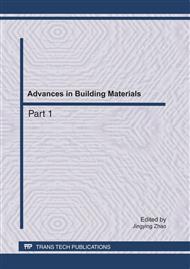p.1370
p.1374
p.1379
p.1386
p.1393
p.1401
p.1406
p.1410
p.1414
Study on Acoustic Emission and Failure Modes of Rock in Uniaxial Compression Test
Abstract:
Based on uniaxial compression test, the mechanical properties and acoustic emission characteristics of rock had been obtained, including the relationship between AE and time, AE and stress level, and so on, in the whole process of rock failure. Research shows AE rate of rock has the subparagraph features obviously. There are three obvious AE sections for the higher strength elastic-brittle rock: First section is compaction stage, corresponding stress is 10% of compressive strength of rock; Second section is crack-development stage, corresponding stress is 80% of compressive strength; Third section is rupture stage, corresponding stress is the compressive strength. Furthermore, AE signals for the rupture stage is strongest. The law is still correct in cycle loading conditions. However, the subparagraph phenomenon isn’t clear for elastic-plastic rock, and the AE peak is lagging behind the ultimate strength of rock, the AE signal in the decline stage of strength is the most intensive and strong. The lagging phenomenon is due to X-shear rupture model of soft rock. The significant stress concentration in cone tip between the two relative extrusion cones leads to local rock broken seriously. Then, many acoustic signals have been observed.
Info:
Periodical:
Pages:
1393-1400
Citation:
Online since:
May 2011
Authors:
Price:
Сopyright:
© 2011 Trans Tech Publications Ltd. All Rights Reserved
Share:
Citation:


